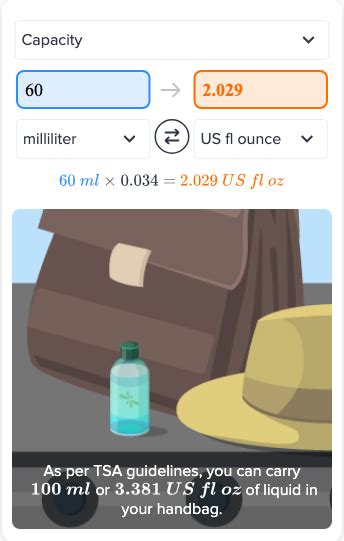How Many Ounces Is 60 Milliliters
Kalali
Apr 02, 2025 · 4 min read

Table of Contents
How Many Ounces is 60 Milliliters? A Comprehensive Guide to Metric-Imperial Conversions
The question, "How many ounces is 60 milliliters?" might seem simple at first glance. However, understanding the nuances of metric-imperial conversions and the practical implications of this specific conversion is more complex than it initially appears. This comprehensive guide will delve into the precise answer, explore the methods for calculating such conversions, and examine the context in which this conversion is frequently used.
Understanding the Units of Measurement
Before we jump into the calculation, let's establish a clear understanding of the units involved:
-
Milliliters (mL): This is a unit of volume in the metric system. It's a thousandth of a liter (1 L = 1000 mL). The metric system is known for its decimal-based simplicity, making conversions within the system straightforward.
-
Ounces (oz): This is a unit of volume in the imperial system (and also used in the US customary system). There are two types of fluid ounces:
- US fluid ounces (fl oz US): Used primarily in the United States.
- Imperial fluid ounces (fl oz imp): Used primarily in the United Kingdom, Canada, and other countries that historically used the imperial system. These differ slightly in volume.
This difference is crucial when performing conversions. We'll focus on both US and Imperial fluid ounces in this guide to provide a comprehensive answer.
Calculating the Conversion: 60 Milliliters to Ounces
The conversion factor between milliliters and fluid ounces is not a whole number, leading to decimal values in the results. The precise conversion factors are:
- mL to fl oz US: 1 mL ≈ 0.033814 fl oz US
- mL to fl oz imp: 1 mL ≈ 0.035195 fl oz imp
Therefore, to convert 60 milliliters to fluid ounces, we multiply the volume in milliliters by the appropriate conversion factor:
For US fluid ounces:
60 mL * 0.033814 fl oz US/mL ≈ 2.02884 fl oz US
For Imperial fluid ounces:
60 mL * 0.035195 fl oz imp/mL ≈ 2.1117 fl oz imp
Therefore, 60 milliliters is approximately:
- 2.03 US fluid ounces
- 2.11 Imperial fluid ounces
Practical Applications and Context
Understanding the context in which this conversion is needed is essential. The accuracy required often dictates whether rounding to a few decimal places or using a more precise value is necessary. Let's consider some scenarios:
Cooking and Baking:
When converting recipes from metric to imperial units, precision is usually important, though slight variations won't drastically affect the outcome. In this case, rounding to two decimal places (2.03 fl oz US or 2.11 fl oz imp) is often sufficient. Using a kitchen scale that measures grams directly might be more accurate than relying solely on volume conversions.
Medicine and Pharmaceuticals:
In medical contexts, precise measurements are paramount. Even minor discrepancies can have significant consequences. In pharmaceutical settings, conversions are often performed with higher accuracy, and the specific type of fluid ounce (US or Imperial) is critically important to ensure patient safety. Using a higher precision in calculations is necessary. Medical professionals would likely use more precise conversion tools than a simple multiplication.
Science and Research:
Scientific experiments demand the highest level of accuracy. In these situations, using the most precise conversion factor and retaining several decimal places are necessary to minimize errors in experimental results. Scientists often work with much larger or smaller volumes where even minor discrepancies in conversions can lead to significant inaccuracies.
Everyday Applications:
For less critical applications, such as estimating the volume of a small bottle of liquid, rounding to one or two decimal places is usually acceptable. For example, saying a 60mL bottle contains approximately 2 ounces would suffice for everyday purposes.
Beyond the Basic Conversion: Expanding Knowledge
While the direct conversion of 60 milliliters to ounces is straightforward, understanding the underlying principles and related conversions is valuable.
Other Relevant Conversions:
- Milliliters to Liters: As mentioned earlier, 1 liter (L) = 1000 milliliters (mL). Therefore, 60 mL = 0.06 L.
- Ounces to Cups: The number of fluid ounces in a cup varies based on whether US or Imperial units are used.
- Ounces to Pints, Quarts, and Gallons: Further conversions can be made to larger units of volume within the imperial or US customary systems.
Improving Conversion Accuracy:
-
Using Online Conversion Tools: Numerous online converters offer high-precision calculations. These tools can handle complex unit conversions and often allow for various levels of precision.
-
Employing Scientific Calculators: Scientific calculators usually include functions to perform unit conversions, providing greater accuracy than manual calculation.
-
Understanding Significant Figures: In scientific contexts, understanding significant figures is essential to ensure the reported results reflect the accuracy of the measurements and calculations.
Conclusion:
Converting 60 milliliters to ounces yields approximately 2.03 US fluid ounces or 2.11 Imperial fluid ounces. However, the accuracy of this conversion depends heavily on the context in which it's applied. Whether you're a baker, a scientist, or simply curious about units of measurement, understanding the nuances of these conversions can be invaluable. Using the appropriate tools and paying attention to the level of precision required will ensure accurate and reliable results. Remember always to clearly specify whether you are working with US or Imperial fluid ounces to avoid confusion and potential errors.
Latest Posts
Latest Posts
-
What Percent Of 15 Is 5
Apr 03, 2025
-
Is Cooking Eggs A Chemical Change
Apr 03, 2025
-
How Does A Doorbell Utilize An Electromagnet
Apr 03, 2025
-
How Much Is 400 Ml In Ounces
Apr 03, 2025
-
How Tall Is 96 Inches In Feet
Apr 03, 2025
Related Post
Thank you for visiting our website which covers about How Many Ounces Is 60 Milliliters . We hope the information provided has been useful to you. Feel free to contact us if you have any questions or need further assistance. See you next time and don't miss to bookmark.
